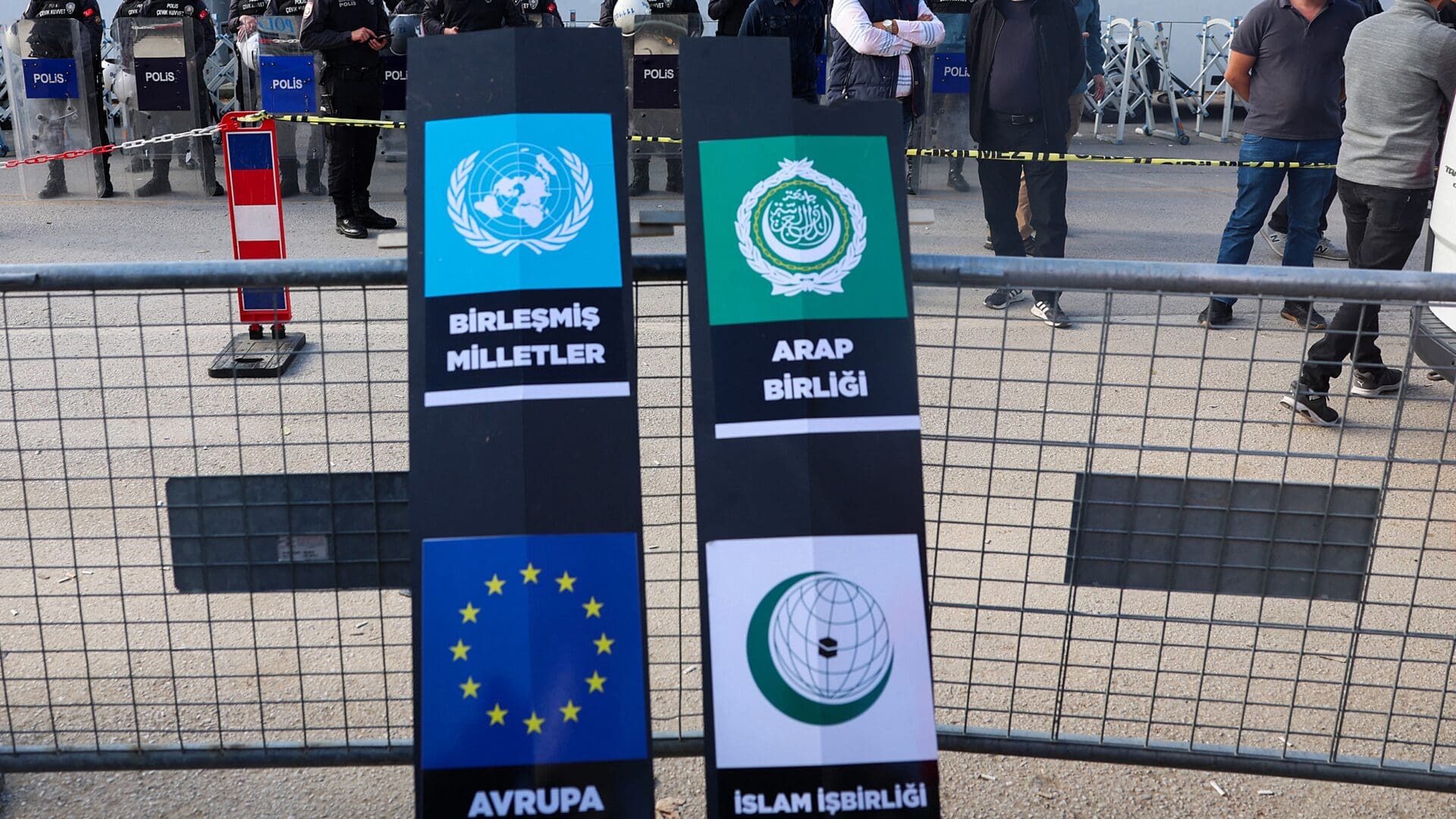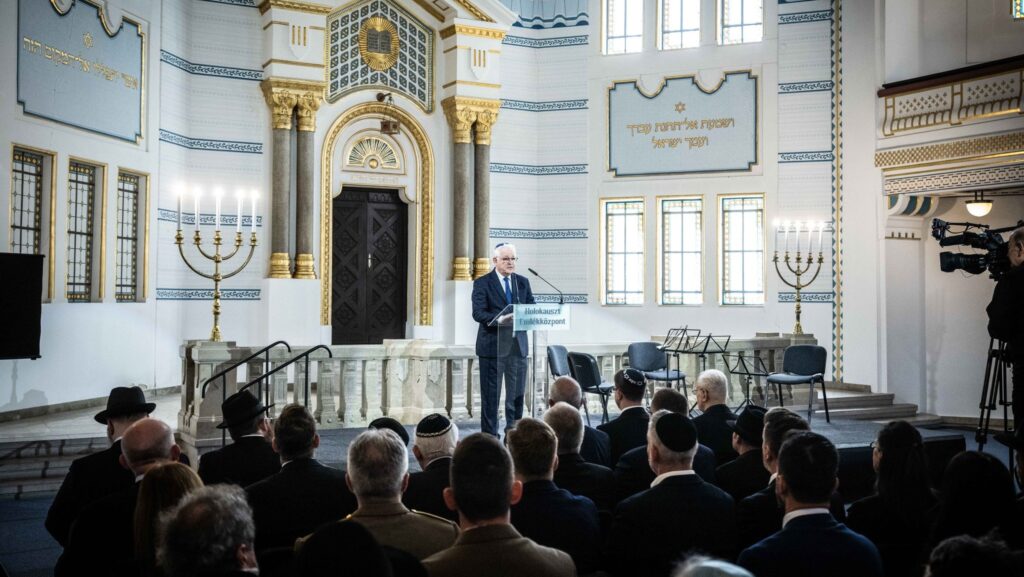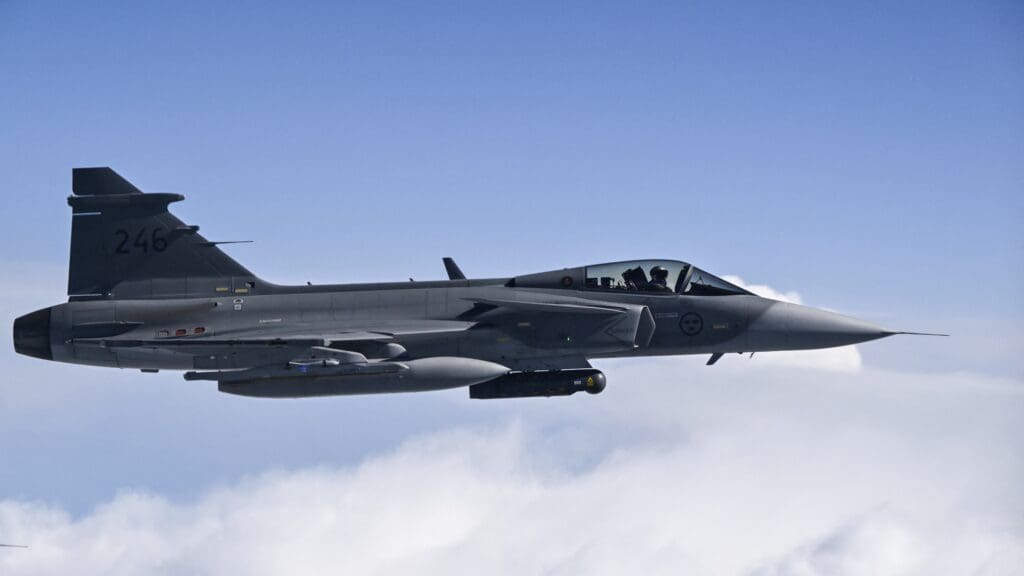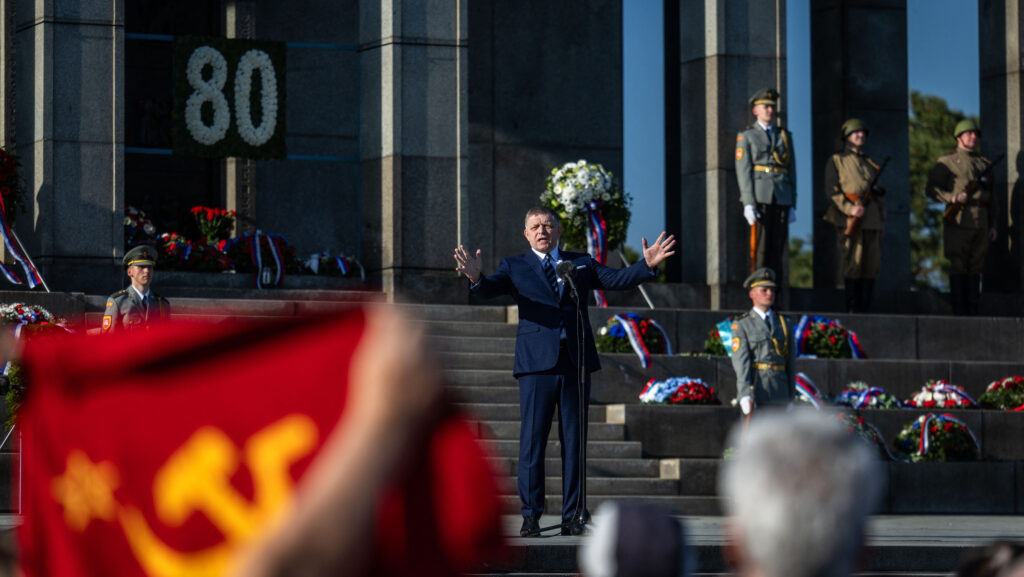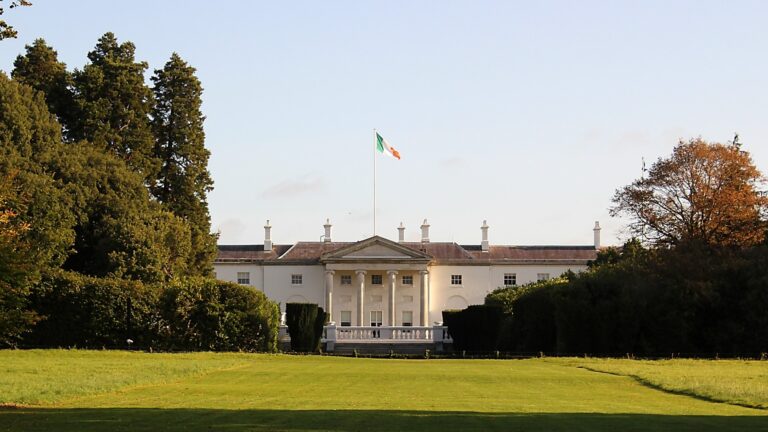The following is the second instalment of a three-part paper[1]. (Editor’s note: For the sake of coherence, the introduction and the conclusion of the analysis are published at the start and at the end respectively of each instalment.)
History did not end after the fall of the bipolar world order in 1990. The ‘West’ failed to take advantage of the historical situation to homogenize the world in its own image and soon the polarization of the world began/continued.
Certain actors started to ask for, if not demand, a leadership role, if not global, at least regional, something the ‘West’ had never granted them, on the contrary, it had made them its targets. As a result, on the geostrategic map of the Old World, a great chessboard, many ‘pieces’ have been given or have won roles and opportunities that they have begun to take advantage of in recent decades. The Western euphoria soon dissipated as it had to face the cultural and religious diversity of the world. Many cultural and religious divergences and the resulting diverging trends have succeeded in breaking the coveted coherence. The ‘West’ has not noticed or understood this—it is, therefore, surprised to see that other regions of the world, other global or regional powers, following different development paths, are succeeding economically and politically and are slowly
building an alternative reality to the ‘West’.
The ‘West’ has realized that if it plays the chess game with the current distribution of chess pawns, according to the traditional rules of chess, it will be checkmated in a few moves. The following paper will examine the challenges and even the breaking points that threaten the global influence and engagement of the ‘West’, including the EU, and that could have far-reaching consequences for the future of the ‘West’, and for Western values itself.
In the last two years, two wars have shaken the world, or at least the global public, which have extremely, if not permanently, divided the world, and accelerated the emergence of two great camps: the ‘West’ and the ‘East’. In addition, the expansion of a new world trade and economic platform and network, the Alliance of the BRICS countries, is now having a major impact on the coherence of the world, which had hitherto been dominated by the ‘West’. The present paper aims to illustrate the three fault lines that are about to redraw the map of the global geostrategic balances of the Old World.
***
The Israeli–Hamas Conflict
On 7 October 2023, some 2,000 Hamas gunmen launched a large-scale attack on Israel’s southern districts and settlements, mainly in the immediate vicinity of the Gaza Strip, with an overload of rocket attacks[2] and by breaching the border security fence around Gaza in multiple locations. The offensive achieved moderate military success (perhaps 123 Israeli soldiers were killed), but the senseless massacre of Israeli civilians[3] (1,400 Israelis were killed, 90 per cent of whom innocent civilians, hundreds were injured, and some 220 abducted) left a scar on the soul of Israel and, indirectly, of the Western world, which will be difficult to heal.
If we look at the sequence of events and their logic, it may at first sight seem surprising that Palestinians living in the West Bank, Ramallah, Nablus, Hebron, or even Bethlehem were not involved in the terrorist attack. Palestinian President Mahmoud Abbas and his party Fatah were not part of the operation either. Whether they disagreed with it or were unaware of it, we do not know. The latter is more likely to be true: Hamas did not inform them of the planned attack for fear of plan reaching the ears of Israeli intelligence. Although Hamas called on all members of Israel’s Palestinian population to take up arms, join the attack and kill their Jewish neighbours, it did not happen. Lebanon’s Hezbollah only made feeble attempts at intervening on the second and third days. The fact that Fatah and the Palestinians in the West Bank, i.e. the Palestinian Authority, were left out of the mindless massacre of civilians is a reflection of the (planned?) result of still having an official Palestinian representation in the eyes of the world that can continue to legitimately claim the right of the Palestinian people to self-determination, to ask for international aid and assistance, and to
represent the Palestinian cause by trying to make the world believe that the Hamas terrorist attack casts no shadow over it.
And this is being achieved by Fatah focusing on the protection of the Gaza Strip and its civilian population, while not condemning unequivocally the brutal atrocities, abominable from the point of view of Western values, committed by the thousands (tens of thousands?) of Hamas members recruited from among the Palestinian population of Gaza. The Palestinian Authority is undoubtedly interested in a negotiated settlement, which may be hindered by the fact that some in the Muslim world question the very existence of the State of Israel, and, ad absurdum, even its right to exist, and talk of a free Palestinian State that stretches ‘from the river to the sea’ (from the Jordan to the Mediterranean), where the State of Israel is today located.
Thus, the terrorist attack can rightly be seen as Hamas’ own operation, in which no other Palestinian groups were involved.[4] Therefore, Hamas has assumed complete political and international criminal responsibility. This act is tantamount to a sacrilege because, while Hamas has shown 1) that Israel is not inviolable; it has also succeeded in 2) stalling the reconciliation process between Israel and the Arab world; 3) creating tension between the Western governments aligned with Israel and the governments of the Arab world, which is almost impossible to resolve, because the West will not back down from its support for Israel and the Arab world will not abandon the Palestinian cause; and 4) restoring support for the Palestinian cause as a major issue among the peoples of the Arab world. At the same time, what it has also achieved is that Israel will use all its might to destroy Hamas, in which it will undoubtedly succeed. It will cleanse Gaza of Hamas, hunt down its members, destroy the territory’s infrastructure, and force the rest of its members into exile, where they will also be hunted.
And Hamas in exile will no longer be the same; it will not be as strong as it was with a concrete territory it ruled over, with its ‘own country’.
The mindless massacre of the civilian population (beheading children, burning families alive, shooting festival-goers, and the list goes on) was a provocation to Israel that cannot go unanswered—and the answer will be harsh: a complete isolation of Gaza; the destruction of all military targets even if they are in civilian disguise (in or under civilian buildings) and even if the critical infrastructure of the city is destroyed; relocation of the civilian population of Gaza from the war zone; and the complete elimination of Hamas in Gaza and outside the borders of Gaza wherever its members may be.
The West, of course, stood up as one for Israel and its values, but it had to face the fact that among Muslims in the Western world, there is practically full consensus that the Palestinian cause must be supported. The Palestinian issue has been one of the neuralgic points of coexistence between Israel and the Arab world for 70 years, and support for the Palestinian cause is so deeply embedded in the cultural code of the Muslim world that it is almost impossible to remove. In Europe, pro-Palestinian demonstrations have erupted, which have totally surprised and shaken the spirit of European citizens who wholeheartedly support Israel in the name of Western values and strongly condemn the atrocities of Hamas’ terrorist attack.
A key issue for the security of Europe and the EU is the level of latency among European Muslims (whether Palestinian or not): whether they strongly condemn what has happened, condemn Hamas, or tacitly agree with it and disguise their hesitation by being willing to talk only about the freedom of Palestine—even though some in the demonstrations did not shy away from openly praising Hamas and calling for the destruction of Israel and the Jews, and talked about a free Palestine (‘from the river to the sea’) without the State of Israel on its map. As long as the Palestinians and pro-Palestinian demonstrators do not condemn Hamas’ brutal terrorist attack, it may be presumed that they may even agree with it in their hearts and possibly even see it as an act of just revenge for the suffering of the Palestinians.
Revealing this latency has become a key issue for European security.
We need to know the level of acceptance[5] of Hamas’ atrocities and what we can expect from Muslims who have found refuge in Europe, how much respect they have for the peoples and states that have welcomed them, and what threat they pose to European/Western values and the security of individual European countries and peoples.[6] After the terrorist attack by Hamas, the anti-Zionism of the Western left, however much effort is made to counter it, can no longer be separated from antisemitism.
As time goes by, it will no longer be the bloody massacres perpetrated by Hamas that dominate the headlines, but the dramatic reports of the apparently inevitable civilian casualties of the Israeli military response and the destruction of Gaza’s urban infrastructure. These will likely be amplified by human rights organizations, the various UN institutions, and the governments of the Muslim world. Several key geostrategic players (Russia, China, Turkey[7], Saudi Arabia, and Egypt) are calling on Israel to show restraint and stop the destruction. However, this is a comfortable position because they know exactly that Israel must eradicate Hamas from Gaza and the entire Middle East, and that this will entail casualties. This position further increases the popularity of Russia and China in the Muslim world.
China is playing an increasingly important role in the Middle East anyway. In March this year, it persuaded the governments of Iran and Saudi Arabia to normalize diplomatic relations with it, became perhaps Saudi Arabia’s biggest oil buyer, and held a joint naval exercise with the Saudi Navy. At the same time, the Saudis are increasingly moving together with Russia in OPEC. In addition, Saudi Arabia will join BRICS, dominated by China and Russia, from 1 January 2024.
To break the growing ‘Eastern’ orientation of Saudi Arabia, a country of increasingly key importance, the United States had again begun to push for Saudi Arabia joining the Abraham Accords between Israel and the surrounding Arab countries. The Hamas terrorist attack has shattered this process, because the devastation of an easily predictable Israeli response is making no one in the Arab world reconcile and ally with Israel, a country that is driving Palestinians from their homes, destroying their cities, and inflicting civilian casualties on the Palestinian people.
In any case,
the sympathy for Palestine that is burned into the genes of the Arab/Muslim world puts its governments in a very difficult position.
The elemental sympathy for the Palestinians among their peoples is in fact so overwhelming that their governments cannot stand with the West on this issue. Besides, the governments of the Arab world also have to fear that the demonstrations of sympathy for the Palestinian cause may trigger popular movements in their own countries, like the ones in 2011–2012 during the Arab Spring. This is why Egypt closed its borders: it did not want to import the Palestinian problem into its country together with the refugees. The images of Hamas terror attacks will soon be replaced by images of the devastation Israel is wreaking in the Gaza Strip—both in human lives and in infrastructure—and the heart-breaking accounts of millions of refugees, which will generate an elemental opposition to Israel—and indirectly to the West—among the peoples of the Arab/Muslim world that their governments will not be able to contain.
Geostrategic Consequences
The immediate geostrategic consequences have not only materialized in highlighting the fragility of Israel’s security (the shortcomings of its intelligence services, the weakness of military security in the southern parts of the country, and the real state of Israel’s preparedness in general) and, by extension, the fragility of the entire security system in the Middle East (how Muslim states reacted to the terrorist attack and Israel’s subsequent response). There is at least one geostrategic consequence that is global.
Such a clear stance by Western governments in support of Israel and such a firm rejection of barbaric terrorism could drive a wedge between the governments of the Muslim world and the ‘West’. This situation is similar to the complete rupture between Russia and the ‘West’, only now the fault line is between the ‘West’ and the Arab/Muslim world. This may be one of the obvious geostrategic consequences of the terrorist attack.
The question, in simple terms, is on whose side the Arab/Muslim world will be in the new bipolar world order—on the side of the ‘West’, or, more likely, on that of the ‘East’. In the current situation, the ‘West’ is clearly at a disadvantage and in zugzwang and must do everything in its power to ensure that the Arab/Muslim world does not move away from it utterly, perhaps even permanently, as a result of the dramatic escalation of the Israeli–Palestinian/Arab/Muslim conflict. If this were to happen, the ‘West’s’ room for manoeuvre in the East and South would be dramatically reduced. Furthermore, the ‘West’ must also do its utmost to ensure that the local conflict in Gaza does not escalate and Israel does not drift into war with its neighbours or other Arab/Muslim states, because this would not only cause a symbolic, psychological, and political rift between the ‘West’ and the Arab/Muslim world but would also affect the global security balance to the detriment of the ‘West’ and place an unbearable burden on the Western military industry in the shadow of the war in Ukraine.
Thus, it is no coincidence that Western diplomacy, and in particular US Secretary of State Antony Blinken, took immediate action and travelled to the Middle East in an attempt to prevent the spontaneous or deliberate widening of the firm fault line that had been established. Let us hope that Western diplomatic efforts will succeed and that the ‘West’, including the EU, will not lose the Arab/Muslim world after the complete break with Russia and China, because that would completely isolate it in a world where the axis of history no longer revolves (and has not revolved for a long while now) around Europe, and where the world’s economic development centres are no longer in Europe and to a large extent no longer in the wider ‘West’ at all, even if the political elite in Western Europe refuses to acknowledge this. Europe and the European Union no longer sit at the global geostrategic chessboard as players, but are at best kibitzers.
In addition to isolating it in terms of foreign policy, the current EU leaders, driven by their own political interests,
have put the EU in a position of being weakened from within with their migration policy,
and in a new world order shaped by rock hard interests, they are dividing and weakening their own internal social base with symbolic politicking and ‘global value-creating’ projects such as open society or gender ideology. Meanwhile, the rest of the world is watching, perplexed but also seeing the opportunity, as the EU destroys the competitiveness of the European economy with its unprecedentedly high fuel prices, high-cost energy, inflation, and other economic policies, and, with its immigration policies, weakens its internal coherence which, as all the centres of power and actors outside Europe know, would be needed more than ever in the new, emerging world order. EU leaders do not know what Europe’s weakness and decadence is doing to the Muslim world and the rest of the world. The non-European part of the world looks on with bewilderment at what is happening in Europe, while at the same time benefiting from its weakness. From there, it is perhaps easier to see that the ship is sinking, yet the band plays on…
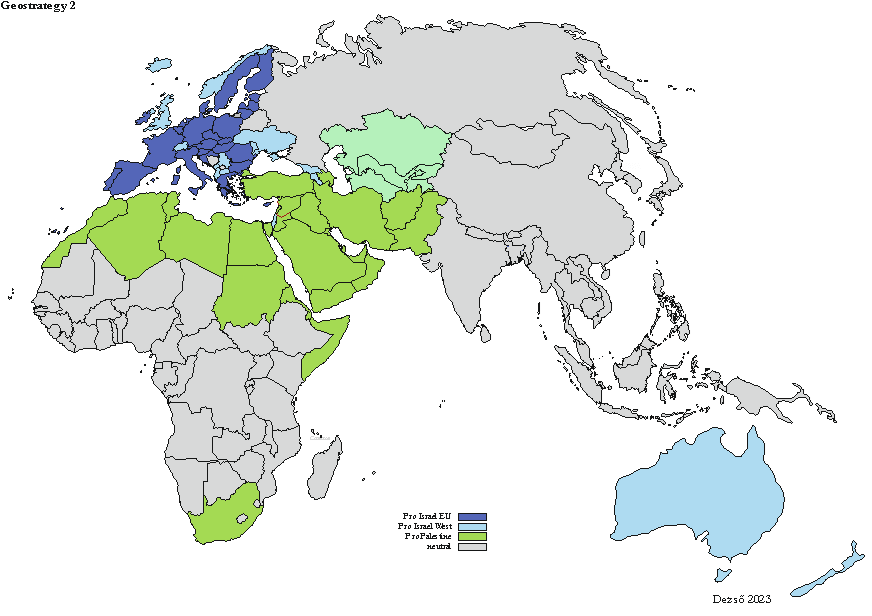
Map 2 shows how the abovementioned fault lines of the Old World. It is also clear that the communication and position of the neutral countries will also be oriented towards Israeli restraint, the protection of the Gaza Strip and the Palestinian civilian population, and ultimately the recognition of Palestinian self-determination (perhaps) at the state level, and that this may open a neutral united front against the ‘West’. Although it will, of course, recognize these values and goals, it will also rightly emphasize Israel’s right to exist as a state and to self-defence.
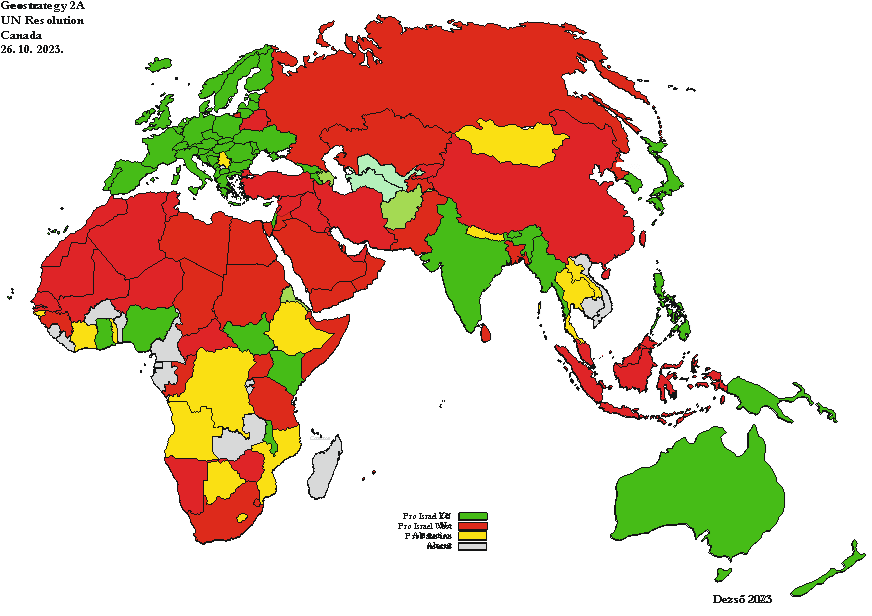
On 26 and 27 October 2023, the UN General Assembly put the debate on the Gaza truce on the agenda. Canada submitted an amendment to the draft resolution presented by Jordan, objecting to the fact that the original draft resolution did not name and condemn the Hamas terrorist attack and the abductions. The amendment was put to debate and vote but did not receive the required two-thirds majority. The result of the vote was 88 in favour, 55 against, and 23 abstentions. As Map 2A and Figure 1 below show, the ‘West’ was still united on this issue, joined by some African countries and India. However, the amendment calling the Hamas terrorist attack and abductions by their names did not receive the two-thirds majority needed to pass, so it was rejected, and the original Jordanian proposal was submitted to the Assembly for a final vote.

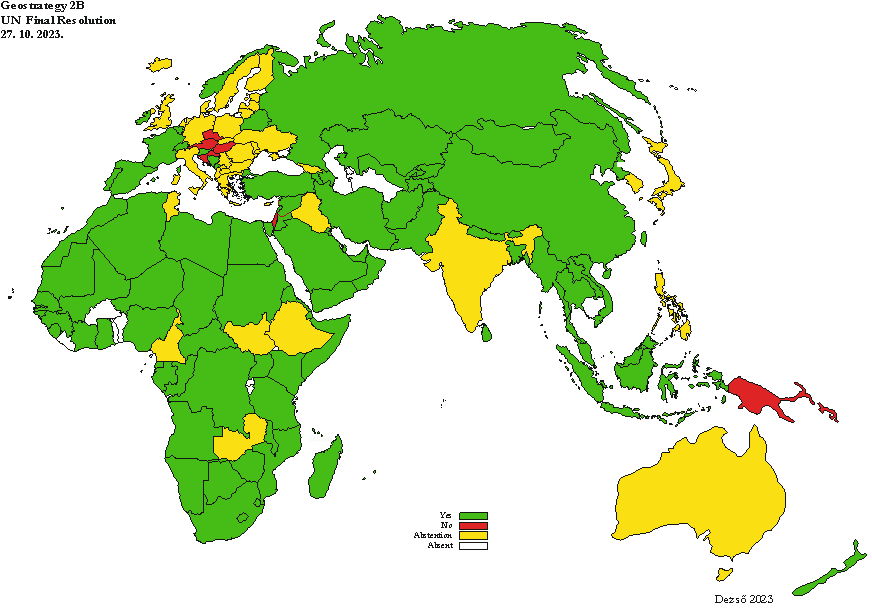
After the Canadian amendment condemning the terrorist attack and abductions by Hamas was rejected, the original Jordanian proposal was put to the Assembly for a final vote. The result is shown on Map 2B and Figure 2 below: 120 in favour, 14 against, and 45 abstentions, i.e., the vast majority of participants supported the original text. In many ways, the result is surprising:
1) The resolution was adopted by the UN General Assembly with 120 votes in favour, a majority of 67 per cent, just over the required two-thirds majority.
2) Some Western European countries (Norway, Ireland, Belgium, France, Switzerland, Spain, and Portugal), either because of their immigrant communities and street demonstrations or because they felt the rest of the world was moving in the same direction, voted in favour of the original resolution, which secured the required two-thirds majority.
3) As some Western media outlets have put it, these Western European countries have left the United States and Israel to their own devices.[8]
4) Except for the United States, Israel, and some Oceania countries, only four Central European countries, Hungary, Croatia, Austria, and the Czech Republic, voted against the original resolution, while several EU Member States and the United Kingdom abstained.
5) Among the Far Eastern countries allied with the ‘West’, South Korea, Japan, the Philippines, and Australia abstained, while New Zealand voted in favour of the resolution.
6) Of the three ‘non-Western’ powers, India first supported the Canadian amendment (not wanting to encourage its own Muslim minority by turning a blind eye to Hamas’ terrorist attacks) and then, after it was rejected in the final vote, it abstained. India’s relations with the Muslim world are not without problems, as it is at war from time to time with Pakistan, one of the major Muslim powers.
7) The two other great powers, Russia and China, on the other hand, voted clearly: against the ‘West’ in both rounds.
8) The entire Muslim world supported the resolution.

The statements after the 7 October terrorist attack may have led us to believe that the ‘West’ was united and unconditional in its support for Israel. In that case, the final vote on 27 October showed that on this issue the ‘West’, or at least some of its states, have already ‘refined’ their position a little and, perhaps bearing in mind the size of their own Muslim communities, the mass street demonstrations, and the far left ‘progressive’ groups marching with pro-Palestinian demonstrators, have supported a position which is important in its aims, namely immediate peace-building, and which does not condemn expressis verbis the terrorist attack by Hamas. Such a bifurcation of the issue may have excused them from the final vote, even if they had supported the Canadian amendment condemning Hamas (Map 2B).
It is clear from the debate and the voting rounds on the UN resolution how dangerous this type of isolation is for the ‘West’ and how it can create a harmony of interests against the ‘West’ among countries outside the ‘Western’ world. It may seem that in this particular case, the harmony of interests is an ad hoc coincidence of emotions, or rather of interests, but this should not fool anyone. Namely, the great powers outside the ‘West’ (Russia and China in particular) will do their utmost to prove that these seemingly ad hoc disagreements between the ‘West’ and the Muslim world are not, in this case, a momentary, easy-to-resolve conflict, but a systemic and irreconcilable conflict (of interest) arising from the different interests, ideas, and traditions of their systems (since non-European countries were once European colonies without exception, and the Christian world has been at war with the Muslim world for a long time anyway[9]), which still serve to maintain Western dominance.
This fracture is a development driven by fundamental cultural differences and real geostrategic conflicts of interest for which the ‘West’ bears indirect responsibility.
Conclusion
The fault lines described above, as well as in the previous, and in the next part of this series of articles, carry the risk of the Western and the EU elites, which are largely unaware of the many directions of development in the world, becoming increasingly isolated. A geostrategic environment is developing around us which, as Map 4 shows, is slowly bringing the ‘West’, especially Europe’s neighbours and rivals, onto a common platform, along different principles and interests.
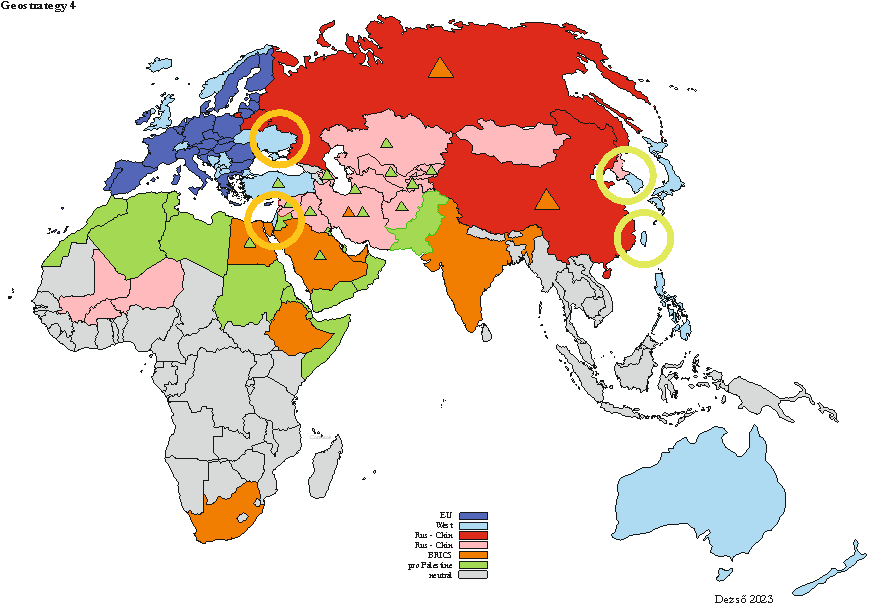
In such a geostrategic context, the current EU leadership seems to be oblivious to, or deliberately ignores, the threats to the future of the EU and the Western world, and pushes themes, such as gender ideology and open society, that are largely symbolic, distracting attention from the real hazards and weakening the EU from within rather than strengthening and enhancing its internal coherence.
The EU—at the latest in light of the mass pro-Palestinian demonstrations in Europe after the Hamas terrorist attack (see above)—must finally realize that uncontrolled immigration is not the solution, but the problem itself, since, contrary to the expectations of Western elites, it has not had the ‘fertilizing effect’ on the economy or society. On the other hand, the unwanted processes that inevitably accompany the arrival of large numbers of immigrants from other cultures and backgrounds occur daily, whether along Hungary’s southern borders or on the streets of Western Europe. The greatest danger of all is the security threat posed by Islamic terrorism. The pro-Palestinian demonstrations, for example, raise the question of whether the Muslim population in Europe can distance itself from the Islamic radicalism of Islamic terrorism, conflated with the liberation ideology of Hamas.
The Russo–Ukrainian war is the most pointless undertaking from the point of view of the EU’s geostrategic interests. It is the bloodiest armed conflict since the Iraq–Iran war, with at least half a million (500,000) victims, the same number of crippled families, seven million refugees, and a partly destroyed country indebted for at least 50 years. Looking at the current and potential crisis zones, from a strictly geostrategic point of view,
the Russian–Ukrainian front, with its symbolic messages, is the most meaningless and bloodiest conflict that is not in the interest of the ‘West’.
Apart from the crippling of Ukraine, it is the EU economy that has suffered the most (petrol prices out of control, inflation, the consequences of the loss of cheap energy for the private and industrial sectors, a dramatic deterioration in the EU’s economic competitiveness, and the list goes on). In addition, the ‘West’, including the EU, has taken on financial burdens that are putting a strain on its budget. Moreover, Western strategic ammunition stocks and arms production have come under unprecedented pressure, posing a substantial threat to the security of the ‘West’. It must also be alert to other crisis hotspots (Israel) and avoid any escalation, as it is probably unprepared for challenges of this scale. If the two other crisis hotspots in the Far East (Korean Peninsula and Taiwan), where there is a threat of a military conflict, were to erupt as well, the ‘West’ would be faced with an almost insurmountable problem from a geostrategic and military point of view. At the same time, it can also be said that for some time now the EU has been the most rapidly arming political community.
In summary, the geostrategic environment around the EU and Europe, partly as a result of the EU’s deliberate decision (breaking with Russia), partly through no fault of its own (the Palestinian issue), and its attitude of only observing the changes in the global economic environment from afar, without being able to influence them in any meaningful way (BRICS+6), has reached a situation that risks isolation.
From the point of view of maintaining the current form and values of the ‘West’, the continuation of a migration policy is life-threatening, because it is triggering internal processes in the Western world which, willy-nilly, will result in the sacrificing the core values of the ‘West’ on the altar of the progressive philosophy of inclusion, and in the weakening from within of its geostrategic position the losing of which could have fatal consequences in a world where the axis of global economic development, population growth, and history no longer revolve around Europe.
Europe and the European Union no longer sit at the global geostrategic chessboard as players,
but are at best kibitzers, even if the EU leadership refuses to acknowledge this.
If the ‘West’, of which this author is an integral and committed part, does not change its present policy, it will soon find itself in a geostrategically hopeless situation.
In the next article, the role of the BRICS countries will be discussed.
[1] This paper is part of a larger comprehensive geostrategic study by the author. As it stands, it raises more questions than answers, but its basic premises allow clear geostrategic conclusions to be drawn.
[2] They claim to have attacked with 2,500 missiles at a time, overloading the Israeli air defence system (the ‘Iron Dome’), which is not calibrated and optimized for a single load of such magnitude.
[3] A distinction must be made between the civilian victims in Gaza who died as a result of Israeli strikes on Hamas targets and those who were victims of deliberate attacks, were deliberately tortured (including children), beheaded according to Muslim traditions, burned alive, or shot one by one. Not downplaying the sense of grief over the deaths of more than 2,000 Palestinians killed so far in Israeli air strikes, it must be pointed out that the vast majority of civilian casualties in Gaza have been caused by precision and fairly accurate air strikes targeted at Hamas bases (warehouses, and control centres, that is, identified military/terrorist targets) hidden inside or under typically civilian residential buildings and other civilian facilities (schools, public buildings such as mosques). There are no reports of Israel deliberately destroying a purely civilian target and civilian people inside it.
[4] This is one of the reasons why the West cannot extend political responsibility to all Palestinian movements and parties and thus continues to support the Palestinians financially.
[5] Back in 2015, the British tabloid The Sun conducted a poll of Muslims in Britain asking whether they supported the aspirations and actions of ISIS (which may have been a contemporary precursor to Hamas terror). 41 per cent of respondents said ‘yes’, which, if you discount Shi’ite Muslims who were both targets and enemies of ISIS, was a shocking result. The paper conducted the poll again after the Bataclan attack in Paris. Its 23 November 2015 edition ran a front-page story showing that at least one in five British Muslims sympathize with the Islamic State (meaning 20 per cent of British Muslims). It is not known whether the sample included Shi’ite Muslims, who are the enemies of ISIS. The paper came under strong attacks for sharing the shocking findings.
[6] In the years of the migration crisis and the rise of the Islamic State, thousands of people arrived in Europe who represented a potential risk and a terrorist threat to Europe’s security. The sudden conversion of second- and even third-generation Muslims in Europe to their parents’ religion, Islam, has resulted not only in terrorist acts in Europe but also in at least 4,558 European Muslims travelling to Syria and Iraq to fight in the ranks of the Islamic State, according to official figures. Of these foreign fighters, 1,192 had already returned to Europe by 2018. For more on this topic, see Tamás Dezső, ‘Foreign Terrorist Fighters in the Islamic State’, in Viktor Marsai (ed.), Terrorism 3.0. Current Security Challenges and Prospects. Conference Volume 2021, Budapest, 2021, Századvég Foundation – Migration Research Institute, 19–102. /
[7] Turkey considers Israel an invader and does not condemn Hamas. Turkey is in a special position because, on the one hand, as a NATO member it belongs to the ‘West’ and therefore other countries of the Muslim world, especially the Arab countries occupied for 400 years by the Ottoman Turkish Sultanate, are suspicious of Turkey, which aspires to what Huntington called the status of a private state in the Muslim world, and which itself abolished the caliphate in 1923. The ‘West’, on the other hand, is also wary of NATO member Turkey, an ally but also one of the main forces of Islamic revival. In any case, being a NATO member state, with its US bases and one of the most powerful armies in the world, Turkey is a key player in all the events in the Middle East.
[8] As the title of Patrick Wintour’s report in The Guardian puts it, ‘US looks isolated after opposing UN resolution on Gaza truce’.
[9] During the caliphal conquests in the 7th and 8th centuries, and later during the Crusades (1095/99–1315) and the Ottoman Turkish conquests.
Read Part I:

